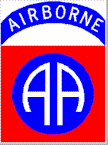
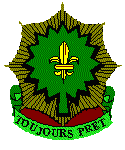
M8 Ridgway Armored Gun System needs citizens' support
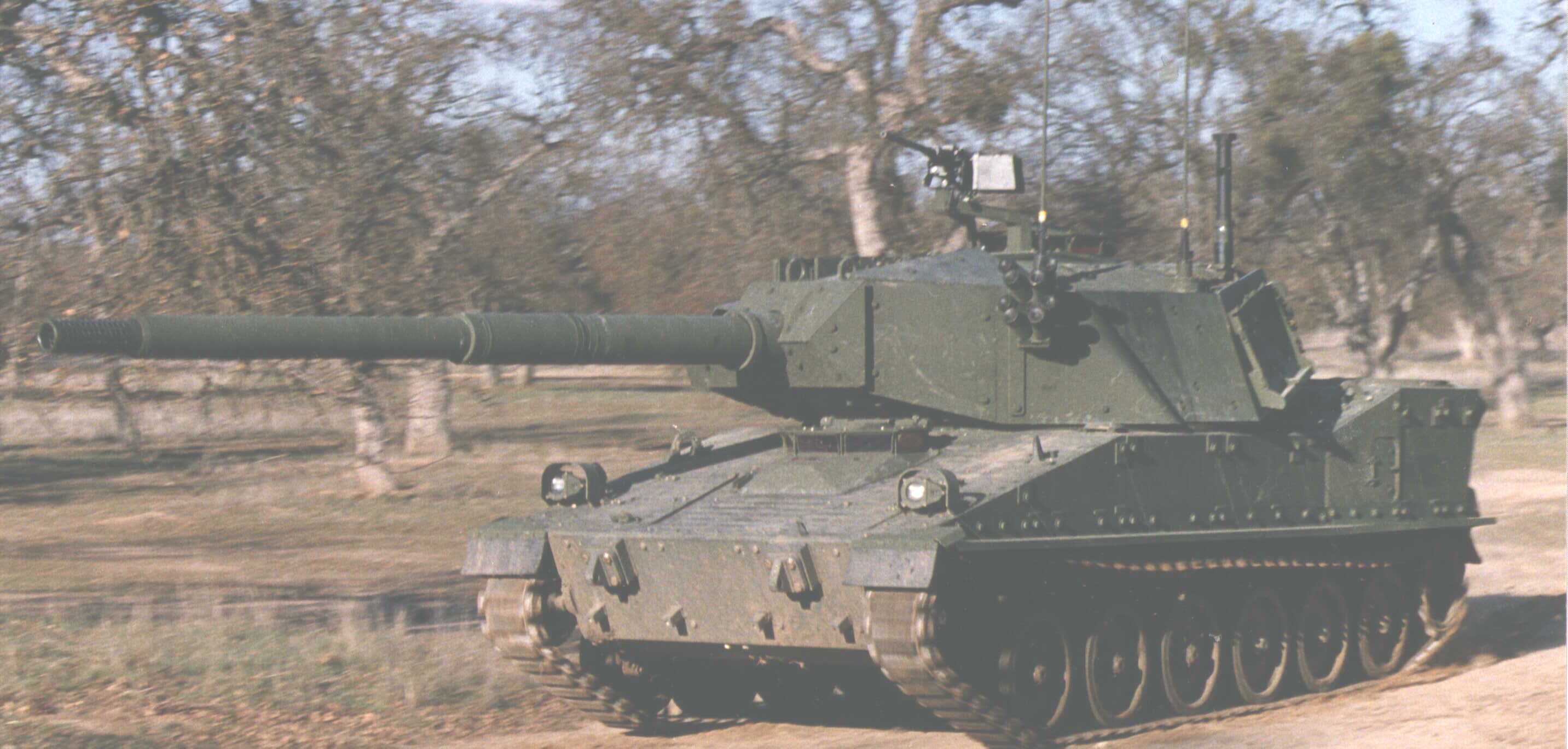
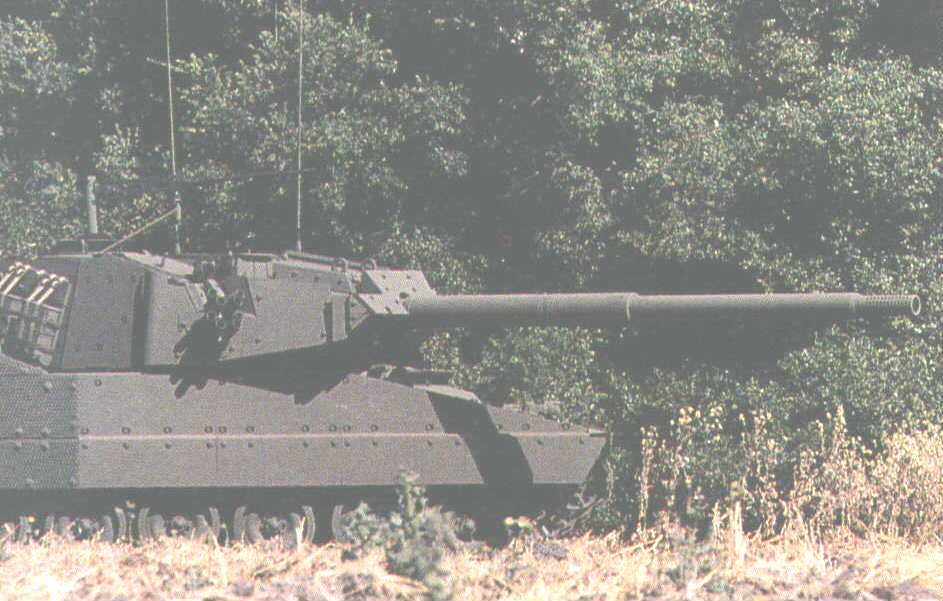
THE FORT BRAGG POST
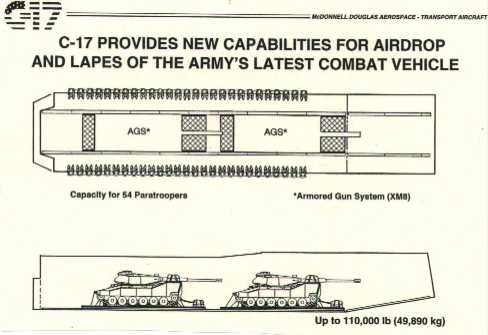
PANAMA, 0110 Hours, 1989
A flight of USAF jet transports screeches through the night skies at just 900 feet..their rear ramps open, drogue parachutes pop out......green light!.....platforms slide out the back end along rollers, each with a M551 Sheridan light tank. The platforms falling end first are righted by huge G-11 parachutes that slowly fill with air. Just as the huge 'chutes open, the platforms land cushioned by honeycomb cardboard. The
'chutes disconnect. 3rd/73rd Armor Battalion Paratrooper-tankers rush to their vehicles, de-rig them and drive them forward into the center of Panama, taking down La Commadancia---the HQs of the enemy resistance with 152mm main gun shock action on an armored tracked platform, the rest is history.
Noriega captured, Panama returned to freedom, U.S. casualties light. A victory for the U.S.
--Colonel M. Thomas Davis, USA, who is currently serving as a Federal Executive Fellow at the Brookings Institute. A separate version of this paper appeared in the 20 October 1996 edition of the Los Angeles Times.
AMERICA'S "FIRST-TO-FIGHT" NEED ORGANIC LIGHT AFVs: SUPPORTING ARMS DON'T WORK IN CITY FIGHTS
Official U.S. Army ACTD web site statement
The U.S. Army's Light Infantry Divisions (LIDs) are America's "first-to-fight" and most important tool in foreign policy. However their bravery must be backed by big gun ground-level fire support coming from Light Armored Fighting Vehicles (AFVs) AKA "Light tanks" that are ORGANIC to them so such assets cannot be denied to them for any reason as they were in Somalia. The forced retirement of the Sheridan and broken promise to replace it with the M8 Buford or Ridgway Armored Gun System (a Light AFV with 105mm or 120mm main gun shock action that can be air-delivered to support our Paratroops) due to alleged "budget cuts" is a serious mistake that fortunately can be easily fixed. For more details of the Army bureucracy's "tap dance" around the facts refer to the ARMY TIMES articles at the bottom of this web page.
America's Army needs a 3-Dimensional, armor-protected warfighting capability---airlanding a handful of M1/M2s isn't going to cut it since this is neither forced entry nor 3D maneuver if you have to seize a runway. A new book by America's leading tactical thinkers explains why we need an "Air-Mech-Strike" capability:
Air-Mech-Strike: 3-Dimensional Phalanx: full spectrum maneuver warfare to dominate the 21st Century @Amazon.com
OFFICIAL AMS web site:
The Ridgway AGS named in honor of General Matthew B. Ridgway, one of the greatest U.S. Army combat leaders of all time, saving the day in WWII as Commander of Airborne forces and Korea in charge of the entire war effort after General MacArthur was recalled by President Truman. This is fitting since the M8 is a light tank designed to be air-delivered along with Ridgway's Paratroopers of today. The M8 Ridgway's ground level fire support is desperately needed today in a world that moves by the speed of the AIR and is rapidly urbanizing.
In fact, official U.S. Army Doctrinal manuals admit this; consider;
"The probability is great that United States forces will become engaged by enemy forces who are intermingled with the civilian population...."
"The increased population and accelerated growth of cities have made the problems of combat in built-up areas an urgent requirement for the U.S. Army. This type of combat cannot be avoided. The make-up and distribution of smaller built-up areas as part of an urban complex make the isolation of enemy fires occupying one or more of these smaller enclaves increasingly difficult. MOUT is expected to be the future battlefield in Europe and Asia.......
"Friendly and enemy doctrine reflect the fact that more attention must be given to urban combat.....
-FM 90-10-1 An Infantryman's Guide to combat in built-up areas
This was written in 1992! Not only is there no excuse for 1993 Somalia, there is no reason why "light-itis" exists in the infantry to fight in cities without AFV SHOCK ACTION. Read FM 90-10-1 online by clicking the hyperlink above. Or go to the U.S. Army Infantry Professional Development (AIPD) web site here and enroll in:
IN 0531 Combat in Built-up Areas
Relying on aircraft for fire support in a city fight to make up for a lack of ground level SHOCK ACTION has been proven to be ineffective:
"It was apparent that neither the Ranger Ground Reaction Force platoon nor Company "C" was going to be able to fight through to the crash site...two helicopters had been shot down in the Bakara Market area in the heart of General Aideed's guerrilla enclave, and a company sized element of TF Ranger
was surrounded and fighting for their lives, taking heavy casualties...."
"The pilots would not fire from stationary positions because of enemy ground fire, but would execute 'running' gun runs...'Running' fire is not as accurate as 'stationary' fire...Air strikes are still only suppressive fire, however, and did not completely destroy enemy positions or buildings. Many
buildings that were struck were reoccupied by Somali guerrillas within minutes..."
Nor can indirect fire from artillery or naval guns be relied on to work:
Current U.S. medium-to-heavy tanks/infantry fighting vehicles (Bradleys =33 tons, Abrams=70 tons) are much too heavy for efficient air delivery in adequate numbers to dominate a battle and are immobile in closed rough terrains such as Bosnia/Afghanistan, where the road nets are destroyed or non-existant; though we are making do there as best we can. The current Immediate Ready Company (IRC) of AIRLANDING a mere 4 M2A2 Bradley IFVs and 4 M1A2 Abrams MBTs while better than nothing, forces the Airborne to have to seize a defended runway for them to be landed. Armored Fighting Vehicle shock action is needed when the Paratroopers are seizing the airhead, not after the battle is over and its safe to land aircraft. The Airborne needs a light AFV that can be airdropped alongside them when they land in the drop zone, so they can quickly overwhelm defenders without needless casualties.
In tight city streets, the turbine-engined 70-to Abrams is difficult to maneuver. Carlton Meyer, noted weapons analyst writes:
"...the U.S. Army has fielded the world's heaviest and most thickly armored tank and infantry fighting vehicle combination: the 70-ton M1 Abrams tank and the 30-ton M2 Bradley Fighting Vehicle. These vehicles are designed almost exclusively for dueling with other armored vehicles. The M1 mounts a massive 120mm high-velocity direct-fire cannon and the M2 Bradley carries a high-velocity 25mm auto cannon and direct-fire heavy antitank missiles.
The M1 tank's weight and limited main gun elevation reduce its effectiveness in the urban, mountainous and wet terrain typically found in potential theaters of operation such as Korea. Heavy armor often requires extensive engineer assistance to cross natural and manmade obstacles. For example, it took three days of intense bridging efforts to get M1 tanks across the Sava River in Bosnia. Finally, the heavy division, with limited infantry and helicopters, is seldom tasked for operations other than war because it has difficulty projecting presence beyond road networks or valleys."
Military Review, March-April 1997, Air-Mech Strike: Revolution in Maneuver Warfare by then Major Charles A. Jarnot, U.S. Army
Our current light tank, the superb M551 Sheridan is worn out and now a training aid at NTC. We need a diesel-engined light tank that is agile in cities and that infantry can follow directly behind: the M8 Ridgway Armored Gun System (AGS)--6 prototypes that underwent testing and now sitting in the United Defense motor pool could be supplied to the 2nd Armored Cavalry Regiment since the 3/73rd Armor Battalion has been inactivated, to give U.S. rapid deployment forces an immediate operational capability (IOC). 6 x M8 Ridgways that can be airdropped NOW to the Paratroopers of the XVIII Airborne Corps beats airlanding 8 x heavy AFVs too late. Other options to pursue are putting a gun system on the superb 11-ton (weighs same as 5-ton trucks organic to U.S. Army Airborne Infantry battalions) M113A3 Gavin AFV. The M113A3 Gavins can replace on a one-for-one basis the Humvee and FMTV 2.5 & 5 ton trucks organic to a designated Airborne Infantry Battalion in each of the 82nd Airborne Division's 3 Brigades, so there would be escort infantry and TOW ATGM and machine gun "female tank" suppressive fires for the M8 Ridgway AGSs big gun "male tank" point target destructive firepower.
M8 AGS PHOTO ALBUM!
M8 AGS being low-velocity parachute airdropped from a C-130!
Awesome "business end" of a M8 AGS!
M8 powerpack: same as used in Army trucks = less logistics costs!
Up-ARMORED Level III M8 AGS: now a main battle tank!
HOW DO WE GET RIDGWAYS INTO SERVICE?
A couple AGS platoons in 18-hour readiness manned by 2nd ACR tankers could give needed armored firepower as a "silver bullet" force just as the RAH-66 Comanche "stealth" helicopter was going to be available in small quantities. We bought the test vehicles, we ought to put them to use. Two platoons is not asking for too much. the M8 AGs was intended for the 2nd ACR. There are a LOT of things that could be done to replace Humvees, too. Make the 2nd ACR the "leading edge" of the XVIII Airborne Corps---light and air-deployable---to do Cavalry missions. Put them on parachute jump status.
Which would be make first contact and maintain contact, keeping the "bad guys" away from the Airhead until the build-up of combat power is finished. The 2nd ACR would have a Company on DRF-1 alert---2 platoons of M8 Ridgway AGS, one to defend the DZ (s) the other to forge ahead with Scout Gavins, some with 106mm RRs to bust up any enemy mech forces coming their way. The 82nd Airborne would have one company (12 M113A3 Gavins instead of Humvees or 2.5/5 ton trucks) on the DZ to be the "Sunday punch" to lead the entire Brigade/Division against assault objectives--most likely a city fight ala' Panama. Those that might say "50" is too small a buy forget that even smaller quantities of FOX wheeled NBC vehicles, RG-31 NYALA mine-protected 4x4s, and Army Security Vehicles (ASV-150s) are in service, and that the M8 uses the powerpack from U.S. Army trucks and components common to other AFVs.
WORTHLESS JETS AND HOW DO WE PAY FOR THIS?
Military Techno-Thriller creator, Tom Clancy writes in his non-fiction book; Airborne-tour of an Airborne Task Force, on page 213, discussing the M8 Armored Gun System (AGS):
However, in a letter to General Dennis Reimer, Chief of Staff, U.S. Army, dated 19 July 1996 he was asked why couldn't the $140+ million spent to close down AGS be used to buy at least a company's worth of M8s or at the very least M113A3 Gavins with 106mm Recoilless Rifles be provided to the 82nd Airborne Division? In response, the Department of the Army, Office of the Deputy Chief of Staff for Operations and Plans, 11 October 1996; Brigadier General John P. Rose wrote: "The $140 million you attribute to closing down the program is actually the amount of Fiscal Year 1996 AGS funding that the Army REINVESTED in OTHER high priority programs. The actual termination cost is approximately $45 million and includes items such as employee actions, property disposal, and completion of contractual commitments..." According to Armed Forces Journal International, $100 million of that money has been slated for a paper study of an "air-deployable" 43-ton "future combat system" (tank) to replace the M1Abrams series. Does "property disposal" mean we throw away 6 x M8 Armored Gun System prototypes already built when they could provide desperately needed air-droppable firepower for the 82nd Airborne? The Army buys 6 light tanks at $5 million dollars of tax-payer money each then throws them away, content that America's Paratroopers will fight and die without a shred of tank support when they jump into the next conflict. If you took all the monies wasted on music bands, paper studies and program cancellations ($322 million) the Army could buy 64 M8 AGS systems to replace the 3/73rd Armor's 56 M551 Sheridans for the 2nd ACR. BG Rose conveniently omitted any reference to using M113A3s/106mm RRs as a AGS substitute. Probably because there is no excuse why M113A3s cannot be provided to the 82nd Airborne Division and/or their attached combat engineers. If the real reason why the 82nd Airborne isn't being provided light AFVs, has nothing to do with money, than what is it?
[Editor's note: I have copies of those letters in my posession from a friend. There's NO EXCUSE why the AGS couldnt have been bought for the 82nd Airborne.]
All of the Army bureaucracy's lying above should have been stopped immediately by Congress and the American people had they been providing oversight. Now years later, men are DEAD and MAIMED from Iraq and Afghanistan because we send them into battle without light tanks. Our NATO allies have figured this out and use light tanks, not the stupid U.S. Army and marines.
There is a growing consensus that the U.S. is spending far too much money on too-fast fighter aircraft that are useless in an urban city or mountain fight and neglecting ground forces equipment that are actually on the scene keeping the peace NOW.
http://www.ausa.org/landwar/item/views/defense979.html
The F/A-18F so-called "Super Hornet" is a turkey. They basically enlarged a regular Hornet by 15% and now have an unstable airplane. We should stop building a 4 of these $73 million dollar turkeys and buy 50 @ $5 million dollar each M8 AGS Ridgwayss for the 2nd ACR.
The U.S. marine corps CRASHES AND DESTROYS enough aircraft each year (they have the highest fatality-accident rate of any of the services) to pay for the entire one-time purchase of the M8 Armored Gun System, at $5 million dollars each which would last us for decades of ground combat use as the M551 Sheridan light tank has served us!
"Monday's crash brought the number of marine corps Class A aircraft mishaps to 12 for fiscal year 1997, the second involving an FA-18D. A crash qualifies as a Class A mishap if it involves a loss of life or more than $1 million in damages.
The Corps lost four of the $28 million FA-18 attack jets in 1996, two of them D models. Three were lost in 1995 and one was lost in 1994, however none of those were D models."
COURAGE IS NO SUBSTITUTE FOR FIRE SUPPORT
Robert W. Black, in his book, Rangers in World War II said the following about the disastrous Dieppe Raid planned by General Bernard Montgomery where commandos assaulted fortified positions with little fire support other than what they carried in their hands;
Just as light tanks and AFVs have proven their worth and saved the day in recent conflicts in Panama, Desert Shield/Storm, Somalia, Haiti and now Bosnia, we need to secure additional funding designated specifically for the U.S. Army to have at least a minimum M8 AGS, M113A3, ground attack AvengerHMMWV force for training and 18-hour Division Ready Force 1 alert readiness.
Consider the British Paratroopers in the Falklands War at Goose Green they attacked without light tanks and took heavy casualties. At Wireless Ridge, they had Scimitar and Scorpion light tanks to fill in when the artillery had to stop or what it couldn't hit and there were almost no casualties. Other Airbornes airdrop light AFVs en masse: the Russians: BMD-2 s, the Germans: the Wiesel, the Israelis: our own M113 Gavin.
The U.S. Airborne has long sought a good light tank; the M-22 Locust and British Tetrarch in WWII were too small and lightly armed having to fit into small American gliders--but larger British Hamilcar gliders were available. Of course, we didn't buy or build any of the larger gliders. The tracked, open top M-56 Scorpion with 90mm assault gun saw combat in Vietnam, but its men were exposed to enemy fire. M18 Hellcats, Super Hellcats, M24 Chaffees and AMX-13 light tanks were available all along for larger glider and C-130 airdrop from the 1950s--but the lazy and dumb Americans didn't even think of it. We also could have developed a turretless-STUG variant of the M113 starting from 1960--or simply plopped a fire support turret on top like many other countries do.
We even modified and cut-down a M113 hull and put an automatic 75mm gun that could swat both aircraft from the sky or blast enemy heavy tanks with 3-round bursts in a low-profile turret into the "Rapid Deployment Force" (RDF) light tank in the 1980s and this still wasn't good enough for our cowardly heavy tankers. Everything and everybody must work around their weak egos--and unwillingness to fight in anything less than an invincible heavy tank.
The Sheridan--weighing the same as a M18 Hellcat we could have had since 1945--clobbered buildings for infantry...now with the M8 Ridgway we finally have a light tank that can also shoot-on-the-move: a match for any other tank and through add-on armor tiles be just as armored as a medium tank, and we give up on it! The Airborne's so-called "handicap" of being without armored shock action is a self-imposed one and a crock of bullshit.
We bought a handful of Comanche scout helicopters to keep the program alive and provide an immediate combat capability; why not do the same with much less expensive M8 AGS Buford-Ridgway light tanks don't "throw the baby out with the bath water" because of self-created budget cuts. We need funding for a M8 AGS force slated for the 2nd Armored Cavalry Regiment at Fort Polk, LA. Army Light Armored Vehicle doctrine is already in place to exploit light AFVs like the M113 and M8 AGS, via Field Manuals available in print or by clicking their hyperlinks.
Write your representatives and plead for the M8 AGS to for the 2nd ACR/82nd Airborne Division-an all out letter writing effort to Congressmen and Senators from all veterans and friends of the Airborne equalling the successful campaign to get the Airborne/glider postage stamp.
Rep. Nancy Pelosi
A Pentagon officer writes making excuses when we know for a fact asshole Armor branch retired generals lobbied behind the scenes and forced weakling CSA Reimer to cancel the AGS:
"Mike,
Thanks for your spirited response. I am convinced that your heart is in the right place.
You are misinformed. The Armored Gun System was not blocked, stopped or canceled by Armor Branch. Branches do not have budget authority. Armor branch expected the AGS to be funded and was very disappointed when it was canceled by the CSA in favor of Apache and Crusader. The budget process--which weapons are bought or canceled--is a very complex process which defies simple solutions.
The decision makers dropped the AGS and took a short term risk for what they thought would be a long term gain.
Should it be this way? Maybe not. But in the real world, what counts is that we have informed, smart people standing up for the right systems, organizations and programs.
Yes, our forces are unbalanced right now--yet we can meet our security requirements today. Is it perfect? No. For the future--as soon as possible in my book--we need a medium armor force, as you and many others have recognized. Your work to bring out this requirement is right on the mark.
The discussion you have generated and your web sites are important additions to the current debate. Keep up the fire and have a great day."
The venerable M551 Sheridan light tank appears to be approaching the end of its career as an Army weapons system.
Next July, 30 years after its introduction, the ungainly vehicle is to be retired from the 82nd Airborne Division's tank battalion, the only deployable unit still equipped with the Sheridan. Following the battalion's inactivation, the only Sheridans left in the Army will be those of the Opposing Force at the National Training Center, Fort Irwin, Calif.
The Opposing Force is also known as the 11th Armored Cavalry Regiment, and by a curious twist, the 11th ACR was one of the first units to receive the Sheridan when it got its first taste of combat in the rice paddies of Vietnam.
According to retired Gen. Donn Starry in his book, Mounted Combat in Vietnam, the Sheridan received mixed reviews from troops in Indochina. It had been designed as an anti-tank platform for airborne forces, and its primary weapon was the Shillelagh missile, fired from its stubby 152mm main gun tube.
But the Sheridan was sent to Vietnam without its missiles, and crews instead relied on the variety of rounds fired by the main gun. Particularly effective against dismounted enemy troops was the canister round, according to Starry.
However, the Sheridan had several significant weaknesses, not the least of which was the main gun's combustible case ammunition; it had a tendency to ignite when the hull was penetrated by a mine or a rocket-propelled grenade, causing a catastrophic secondary explosion that destroyed the vehicle. This flaw earned the Sheridan a reputation as a dangerous vehicle in which to fight.
Reliability problems continued to plague the Sheridan fleet during the 1970s and 1980s. The Shillelagh missile was considered effective up to 3,000 meters. However, because gunners had difficulty tracking the missile after launch, it was useless at ranges over 1,200 meters. The Sheridan eventually was replaced by other systems in the Army's cavalry organizations, leaving only the 82nd relying on its firepower.
In situations where the Sheridan was not asked to go toe-to-toe with top-of-the-line enemy equipment, however, its very size could prove intimidating. Such was the case during Operation JUST CAUSE, the invasion of Panama in 1989, where the Sheridan represented overwhelming firepower compared to the assets of Panamanian strongman Manuel Noriega's armed forces.
The Sheridan might have fared a little worse the next year, had Saddam Hussein's armored divisions thrust south from Kuwait into Saudi Arabia as the 82nd arrived to draw the United States' line in the sand during Operation Desert Shield. Fortunately, the Iraqi leader pulled his punch, and the Sheridans did not trade blows with the Iraqis' T-72s.
The Airborne Division also had plans to use the Sheridan in its invasion of Haiti in fall 1994. A last-minute peace deal brokered with the Haitian military junta halted the operation. It was replaced by a peaceful entrance by a task force built around the 10th Mountain Division (Light Infantry), Fort Drum, N.Y.
The aircraft carrying the 82nd's invasion force turned around and headed back to Fort Bragg, apparently carrying with them the Sheridan's best chance for a last hurrah. But the tanks only spent a couple of days back in North Carolina before the decision was made to send them down to Haiti anyway, to intimidate any disaffected elements who might be foolish enough to pick a fight with U.S. troops in the country.
Army Times
By Sean D. Naylor
The Army originally planned to give the EFOGM company to the 101st Airborne Division (Air Assault), Fort Campbell, Ky., to evaluate. However, concerns over the 82nd's anti-armor capabilities are prompting a revision of that decision, and it now appears likely that the 82nd will get an EFOGM company by the end of the century. Reimer even raised the possibility of bringing the ACTD forward. [2011 EDITOR: WHAT EFOGM HUMVEES? Cancelled.]
The Enhanced Fiber Optice Guided Missile,, mounted on a heavy Humvee chassis, is designed to destroy tanks and helicopters at up to 15 kilometers. It is one of the ways the Army hopes to compensate for the now-defunct Armored Gun System.
"We'd like to be able to accelerate that ACTD and maybe put EFOGM in the 82nd," he said.
* Line-of-Sight Antitank (LOSAT). Another promising system some years away from production, LOSAT consists of an armored chassis mounting a kinetic energy missile launcher. [2011 EDITOR: WHAT LOSAT? Cancelled. More lying fantasy bullshit from the Army bureaucracy.]
Tests in the early 1990s showed the missile, which travels at around a mile per second, to be devastatingly effective against armored targets. However, when the Army's Armored Systems Modernization program was restructured in 1991-1992, it was put in what the service calls the "tech base," essentially a back-burner position in the Army's procurement arena, with limited money available for refining the system, but no funds to buy it or field it.
Nevertheless, Reimer and Anderson both sing LOSAT's praises loudly. Reimer described the system as "dynamite."
"It's a lightweight system that I think would give all the combat power that the 82nd, or any other force, would need," he said. [2011: He is full-of-shit; if it DOESN'T EXIST, it doesn't do shit for anyone except con our Soldiers that things are AOK when they are not.]
"I'd be so bold as to say it is definitely the most capable anti-armor system, once it's developed, if it lives up to its reputation, that you'll see," echoed Anderson. "Nothing will be able to defeat it, except for a tank that maybe has three-foot-thick walls." [EDITOR: tanks that already exist defeat it because IT DOESN'T EXIST.]
But Anderson cautioned that there were reasons why the Army was not already mass-producing such a promising weapon system. "First of all, we have not overcome the technological hurdles associated with LOSAT," he said. In addition, he said, LOSAT has the twin drawbacks of being very expensive and "a single-function system....It's only a tank killer."
[2011 EDITOR: that's why you should have bought LIGHT TANKS that can not only blast tanks they bust bunkers and dug-in enemies]
The Army is about two years from deciding whether to produce LOSAT, meaning that it would be at least four or five years before the system was fielded with troops, Anderson said. Reimer, Anderson and other Army leaders in Washington are confident that a combination of the systems detailed above will be more than adequate to fill the void left by the painful cancellation of the AGS.
"What we're looking at is phasing the Sheridan out and phasing something else in, d> how we bridge that gap," Reimer said. "But I am comfortable that we will be able to provide the 82nd the required amount of fire power under any circumstances." [2011 EDITOR: ask the families of the dead Paratroopers who lacked fire support in Afghanistan during the 2008 battle for Wanat village]
Officials at Fort Bragg are far less willing to display any public enthusiasm for the Army's planned remedies, however. 82nd Airborne commander Maj. Gen. George Crocker vetoed an Army Times request to cover his division's 2nd brigade working with 3-73 Armor Sheridans at the Joint Readiness Training Center, Fort Polk, La. He also refused to allow any of the tank battalion's personnel to be interviewed by Army Times on the subjects of how the 82nd employs its tanks, and how well the 30-year-old Sheridans are holding up.
For their part, officials at XVIII Airborne Corps headquarters joined with Crocker in refusing to answer questions about how the corps plans to integrate the Immediate Ready Company with the 82nd's paratroop brigades. Among the issues they declined to discuss were:
* The extent to which the firepower of four Abrams tanks and four Bradley Fighting Vehicles can compensate for the loss of a 58-tank armor battalion.
* The challenges of training 3rd Infantry Division (Mechanized) Soldiers used to heavy armor doctrine to adapt to the requirements of a light infantry force.
* The degree to which the IRC will be able to replicate the close ties that exist between 3-73 Armor's companies and the 82nd's infantry brigades.
The reasons for the 82nd and XVIII Airborne officials' reluctance to address these issues publicly can only be guessed at, but their reticence will do little to calm the fears of Soldiers like SSgt. Audette. "The Army is just trying to find a quick solution," he said. "It'll never be a replacement for what 3-73 did for the 82nd...Personally I don't think it's going to work."
[2011 EDITOR: Guess what? Audette was proven right, wasn't he?]
Army Times
By Sean D. Naylor
The inactivation of the 82nd Airborne Division's only tank battalion has brought into sharp focus questions raised in January when the Army canceled the Armored Gun System with which the battalion was to be equipped.
The Armored Gun System (AGS), a light tank that could be airdropped into battle, was intended as the replacement for the outdated Sheridan tanks of 3rd Battalion, 73rd Armor Regiment, the tank battalion of the Fort Bragg, N.C.-based 82nd Airborne.
With all funding for the Sheridan scheduled to end in 1997, the battalion's inactivation, announced Sept. 11, became almost inevitable.
But together, the two decisions have left Army leaders in the difficult position of arguing that removing the 82nd's armor force will not negatively impact the Division's warfighting capability, when less than a year ago they were arguing that the Army -- and the Division -- had a genuine need for the AGS.
The 82nd is the Army division most likely to be sent into combat on short notice. Its three Brigades of Paratroopers take turns as the "division-ready brigade," which must be ready to depart for combat within 18 hours of notification. The division-ready brigade task force typically includes a Sheridan company from 3-73 Armor.
Even with the Sheridan, it is debatable whether the 82nd can compete with the main battle tanks with which many potential U.S. adversaries are equipped. When the Division became the first conventional ground force deployed to Saudi Arabia during Operation DESERT SHIELD, its members derisively referred to themselves as "speed bumps," a reference to their lightly armored presence in the path of the Iraqi armored forces massed across the border in Kuwait. The AGS was not designed to trade punches with modern main battle tanks. However, its 105mm main gun, and three different armor packages that allow it to be airdropped at a weight of 20 tons -- and then have up to 11,000 pounds more armor added to it once on the ground -- would make it more survivable on the modern battlefield than the Sheridan, and would certainly add to the Paratroops' ability to take on an opponent supported by heavy armor.
Decision questioned
Army Chief of Staff Gen. Dennis Reimer's decision to cancel the AGS was questioned at the time by some Soldiers who were concerned that it would critically weaken the 82nd's ability to confront enemies equipped with main battle tanks.
"This weapons system is urgently needed in the Army inventory to meet those kinds of missions that we find ourselves increasingly faced with performing," said one field-grade armor officer in the wake of the decision. "The 82nd Airborne goes in buck naked when they go in some place without this kind of heavy-weapons fire support."
SSgt. Christopher Audette was equally blunt in an April 22 letter to Army Times, decrying the decision to cancel the AGS. "One would think the leadership at the top would try harder to make sure the high-speed 82nd Airborne Division had the right equipment to do their job," he wrote. Audette, now out of the Army, was with 3-73 Armor at the time of his letter. He served as both a tank commander and a scout section leader during two years service in the battalion.
Audette emphasized the advantages paratroopers enjoy in having a tank that can be air-dropped."When we heavy drop our tanks at 1,200 feet, and we follow two minutes later at 800 feet, we meet our tanks on the ground. Within 10 minutes we are moving toward our objective with a squad of infantry on our tanks ready for combat," he wrote.
In a recent interview, Audette said subsequent events had done little to change his views. "You can't send light infantry into a hostile area without any sort of light armor support at all," he said. "They just don't have the firepower to defend themselves.".
[2011 EDITOR: THIS IS EXACTLY WHAT IS HAPPENING NOW! AMERICAN LIGHT INFANTRY WITHOUT LIGHT TANKS GETTING CREAMED IN THE MOUNTAINS OF AFGHANISTAN! JUST AS AUDETTE WARNED US.]
Army officials stress that the decision to cancel the AGS was made simply because it had more pressing needs for the $1.5 billion it would have cost to field the AGS to 3-73 Armor and the 2nd Armored Cavalry Regiment, the only two units in line to receive the system. According to Maj. Gen. Edward Anderson, assistant deputy chief of staff for operations and plans for force development, the decision was a difficult one for Reimer.
"He really struggled with it in terms of trying to determine, certainly, what's best for the 82nd, and then at the same time, what's best for the Army," Anderson said. "And so he wrestled with it; we helped him, provided information, and he did an awful lot of research on his own...and finally made the gutsy decision. It was a hard decision."
But Anderson and other Army officials are adamant that service leaders would never allow the 82nd's Paratroops to be deployed into a situation in which they did not have the means to defend themselves or to accomplish their mission. "We are just not going to do that," Anderson said.
[2011 EDITOR: WHAT DO YOU MEAN NEVER DO THIS? YOUR SUCCESSORS AT HQDA ARE DOING IT N-O-W.]
Hoping to fill the gap
Army sources said that in the memo Reimer sent to then Forces Command chief Gen. John Tilelli Sept. 4, informing him of the decision to inactivate 3-73 Armor, he also tasked Forces Command (FORSCOM) to brief him within 60 days on the measures that would be taken to provide armored support to contingency forces, such as the 82nd.
Both Reimer and Anderson said they and other service leaders are hoping a variety of new weapons systems, combined with some new ways of using established systems, will fill the gap left by the AGS cancellation. As outlined by Reimer in an Aug. 16 meeting with Army Times editors and reporters, and fleshed out by Anderson in a subsequent interview, the following are the principal ways in which the Army hopes to compensate for the loss of the AGS:
* The C-17. The C-17 Globemaster III is the newest Air Force transport aircraft. It is designed to ferry troops and equipment over strategic distances before landing on and taking off from unimproved airstrips.
This capability means that so long as U.S. forces control at least one airfield close to the fight, the United States can fly in heavy ground combat vehicles, such as the M1-series Abrams main battle tank and the M2-series Bradley Fighting Vehicle, to support such light contingency forces as the 82nd's Paratroops. [Editor: Non-sense; not forced-entry or 3-Dimensional maneuver warfare; these bloated tanks cannot operate in closed terrains]
Reimer noted that in December 1995, a month before the AGS cancellation, the C-17 successfully conducted one of its first missions by flying troops and equipment into Bosnia. "The C-17 gave us great, great support in moving Bradleys into our sector," he said. "We became convinced that the C-17 was everything and more that it was billed as."
* The Immediate Ready Company (IRC). The IRC is a company-size task force from Fort Stewart, Ga.'s, 3rd Infantry Division (Mechanized). Its combat power consists of four M1A1 Abrams tanks and four M2A2 Bradley Fighting Vehicles.
It also includes a command and control element, as well as a support element that has two fuel Heavy Expanded Mobility Tactical Trucks (HEMTTs), one cargo HEMTT and one ambulance.
The IRC is designed to deploy into battle with the 82nd's contingency first forces. It is based at Hunter Army Airfield, Ga.
Although the Division rotates troops through the task force on a regular basis, the equipment is permanently stationed at Hunter. Like the 82nd's Division-Ready Brigade, the IRC is required to be "wheels up," that is, loaded on an aircraft en route to a mission within 18 hours of orders. [2011 EDITOR: and fly WHERE? If there is no runway for the mech pussies to be gingerly airlanded?]
It deploys with five days of ammunition and sustainment supplies, according to Fort Stewart spokesman Dean Wohlgemuth.
"We felt that once we take the Sheridan out of the 82nd, we could combine e 82nd> with a package, probably from the 3rd Infantry Division as a flyaway package, a heavy package," Reimer said, "Bradleys or Abrams tailored to whatever the mission may require, to provide the mobile firepower that it would need."
Audette raised this issue in his letter to Army Times. "We now have the experts telling the Division that the Army will bring some Bradleys here to replace the tanks," he wrote. "This idea will not work because here at the Airborne, we do not airland; we jump!"
Even if an airfield is available, there are other drawbacks to airlifting in armor support. "The C-5 and the C-17 can carry only one tank a time," Audette wrote. "That would take a lot of time and fuel. This makes no tactical sense."
Reimer is not overly concerned by these factors [He doesn't have to fight or risk death], however. "Obviously that IRC will not be air-droppable, but it will be able to land in an airfield nearby and I think will provide the 82nd the support they need," he said. "I think being able to fly the Bradley and the Abrams into an area very quickly and combining them with the 82nd will give them a tremendous punch."
[2011: what an idiot. If they can't get there there provide ZERO punch. Reimer had to be the worst Army CofS ever.]
* The 18th Aviation Brigade. Based at Fort Bragg, the 18th Aviation Brigade belongs to XVIII Airborne Corps, and its AH-64 Apache attack helicopters give it a lethal tank-busting punch that the corps commander can use to support the 82nd, should he so desire.
"Set aside the fact that you don't have an airfield to bring your Brads and your tanks in, you've got Apache," said Anderson. "They can ferry themselves to any theater just about anywhere, and they don't have to be airdropped in. They can be there in conjunction with the attack."
[2011 EDITOR: more horseshit. Light infantry without light tanks gets clobbered by the enemy and AH-64s come afterwards to ward the enemy off like at the 2008 battle of Wanat. 8 men dead because of Reimer and Anderson's bullshit.]
But Anderson acknowledged that self-deploying the brigade's Apaches directly into battle is not without its challenges. "That's a very, not difficult, but delicate operation to orchestrate, but we can do it," he said. "We've demonstrated that."
[2011 EDITOR: like the Task Force Hawk clusterfuck?]
The 82nd had its own Apache battalion until 1993, when then XVIII Airborne Corps Commander Lt. Gen. Henry Shelton had the Apaches replaced with the lighter, but less lethal, OH-58D Kiowa Warriors. The Kiowa Warriors can be airlifted and prepared for battle much more quickly than can Apaches, but are less effective than the larger, more modern attack birds.
After Reimer canceled the AGS, XVIII Airborne Corps commander Lt. Gen. Jack Keane asked FORSCOM to put the Apaches back into the 82nd, according to Army aviation officials.
No action has been taken on that request,but Anderson noted that the Aviation Center at Fort Rucker, Ala., has recently completed a comprehensive review of Army aviation that will be briefed to Army Vice Chief of Staff Gen. Ronald Griffith about Sept. 20.
"I believe one of the things they're looking at is the Apache in the 82nd, Apache distribution across the force," Anderson said. "I'm hesitant to say it definitely will come up in that...but I'm pretty sure it will." [2011 EDITOR: the simpler and better answer is to not be an asshole and supply the 82nd the light tanks they need than a million of these band-aids]
* The Javelin. Previously known as the Advanced Antitank Weapon System-Medium, the Javelin is the long-awaited replacement for the light forces' Dragon anti-tank missile.
Designed to be carried into battle by the infantry, the Javelin is a fire-and-forget shoulder-launched missile that should greatly improve the 82nd paratroops' ability to engage and destroy enemy tanks and other armored vehicles. [2011 EDITOR: didn't do jack-shit to help Combat Out Post Kahler at the 2008 battle of Wanat]
Both Reimer and Anderson noted that the Army has accelerated production and fielding of the Javelin, meaning that the 82nd's Paratroops will have the missile in their hands in April 1997. [2011 EDITOR: too big to safely jump attached to a Paratrooper]
Audette echoed the Army leaders' confidence in the missiles' capabilities. "The Javelin is a good system, I'll give you that," he said. "It'll defeat Soviet bloc equipment right up to the T-72 tank." But Audette is worried about the system's weight, which is just under 50 lbs. "How much more gear are these guys going to have to jump in with?" he asked.
* The Enhanced Fiber Optic Guided Missile (EFOGM). Mounted on a heavy Humvee chassis, the EFOGM is designed to destroy both tanks and helicopters at ranges up to 15 kilometers. [2011 EDITOR: CANCELLED]
In the medium term, this promising developmental system may take the place of the Sheridan in the 82nd, although not on a one-for-one basis, according to Army officials. It is one of the weapons being evaluated in the Rapid Force Projection Initiative Advanced Concept Technology Demonstration scheduled to begin at Fort Benning, Ga., in July 1998.
Army officials hope this demonstration of several unfielded weapons systems will help them decide which to concentrate resources behind in an attempt to speed procurement of those systems most likely to add lethal punch to the Army's first-to-fight contingency forces.
Two EFOGM platoons of four firing vehicles and one non-firing platoon leader vehicle each will be given to XVIII Airborne Corps to participate in the demonstration. Key to the ACTD concept is putting the systems in Soldiers' hands to better evaluate their potential. At the conclusion of the demonstration in 1999, the corps will receive another platoon, to give it a full company's worth, for a two-year "extended user evaluation" of the weapon. When the full company has been established, in late 1999, the unit will be considered deployable.
Army Times
By Sean D. Naylor
The Army will inactivate the 82nd Airborne Division's only tank battalion by July 1997 and give its tanks to the National Training Center, Fort Irwin, Calif., it announced Sept. 11.
The decision to take down 3rd Battalion, 73rd Armor Regiment had been expected since the January cancellation of the Armored Gun System (AGS), the light tank that was to have replaced the aging M551A1 Sheridan with which the battalion is equipped.
Because all funding for the Vietnam-era Sheridan ends in 1997, there has been doubt that the 3-73 Armor could survive as an airborne armor battalion. Unlike the M1-series Abrams tank and the M2-series Bradley Fighting Vehicle, both the Sheridan and the AGS could be parachuted into battle.
Army Chief of Staff Gen. Dennis Reimer made the formal decision to inactivate the battalion Sept. 3, and sent a memo to Forces Command at Fort McPherson, Ga., to that effect Sept. 4, according to Army sources. The battalion itself was informed Sept. 9, said Army spokesman Maj. Stan Heath.
Concern for the troops?
Army sources said the well-being of the battalion's 563 Soldiers and their families was paramount in Reimer's mind when he made the decision. [BULLSHIT. Paramount was destroying Airborne warfare capabilities because the leg Generals were jealous] "That was the chief's concern, to minimize turbulence for the Soldiers," said one Army source. [Is being dead in a body bag, reducing the turbulence of one's life?]
A team from Total Army Personnel Command (PERSCOM), Alexandria, Va., will visit Fort Bragg as early as the week of Sept. 16 to interview the Battalion's Soldiers and begin the reassignment process, the source said. Although the battalion is an armor unit, the Battalion's principal MOS is 19D, cavalry scout, rather than 19K, M1 crewman; the PERSCOM team will investigate how many Soldiers will need retraining, he said.
The first troops are likely to be reassigned in February, but most of the married Soldiers with children are unlikely to move until June when the school year ends, the source said. The formal inactivation of the unit, the only Light Tank Battalion remaining in the Army, is expected to take place no later than July 15, 1997. It is not yet known when the battalion will cease to be available for combat operations, the source said.
$3 million annual budget
The battalion has an annual operations and maintenance budget of almost $3 million and has 58 Sheridans plus two "floats" -- vehicles that can be used when others are down for repairs, the source said. [GEE. Now they want to spend $4 MILLION per SUV-tired armored car, 330 of them in each peacenik brigade. Not having enough money to keep light tanks in the Army sounds like anti-Airborne warfare BULLSHIT, doesn't it?] All the Battalion's Sheridans will be sent to the National Training Center, where the Opposing Force uses visually modified Sheridans to replicate Soviet-style weapons systems.
In a related development, the only other unit slated to receive the AGS, the Fort Polk, La.-based 2nd Armored Cavalry Regiment, will remain a "light" outfit for the foreseeable future, an Army official said Aug. 28. The regiment used to be equipped with M1A1 Abrams tanks but now rides around the battlefield on Humvees.
"The plan right now is to leave the 2nd ACR as a light force," said Maj. Gen. (P) Edward Anderson, assistant deputy chief of staff for operations and plans for force development. In the wake of the AGS cancellation, many Army pundits had predicted the regiment would be "heavied up" with Abrams tanks and Bradley Fighting Vehicles, but this isn't the case, Anderson said.

"In reviewing these actions it is apparent that some military capabilities have been quite useful while others have assumed a much more modest role. In Panama, Haiti and Somalia the principal instrument of American power was its Light Infantry Divisions. Secretary of State Warren Christopher noted that, 'despite the threat of air and naval attack, it was only when the Army's 82nd Airborne Division was in the air that the Haitian government of General Cedras stepped aside and agreed to the restoration of power to President Aristide.'"
"Within this evolutionary climate, fiscal realities and the aging of existing systems have resulted in a significant gap in our forced/early entry capabilities. The deactivation of the 3rd Battalion, 73rd Armor, coupled with the termination of the Armored Gun System (AGS), has created a critical need for enhanced direct fire assault support and anti-armor capabilities for forced/early entry forces".
"....urban growth in all areas of the world has changed the face of the battlefield.........."
IN 0726 Military Operations on urban terrain (MOUT) Offense
INO 736 Military Operations on Urbanized Terrain (MOUT) Part II
"The Ranger platoon had been unable to break through after being badly ambushed, losing one or two vehicles and suffering several casualties......"
-U.S. Army Cpt. Charles Ferry, a leader in the battle to rescue U.S. Army Rangers trapped in Mogadishu, Somalia on October 3, 1993. The deadlock wasn't broken until allied nations with armored vehicles (some U.S. hand-me-down M-48s/M113 Gavins) were begged and coerced by the 10th Mountain Division (Light) to come save the Rangers and Delta operators.
IN 0531 Combat in built-up areas states:
"The direct-fire system is the most effective fire support in built-up areas. Once a target can be located in a building, one or two direct-fire rounds can accomplish what entire salvos of indirect-fire artillery cannot. Direct fire support is key to success in fighting in built-up areas..."
"Another advantage is that a diesel engine produces far less heat, so tanks would be less vulnerable to new infra-red mortar rounds and heat-seeking top-attack ATGMs like Javelin. More importantly, the current gas turbine engine produces so much heat that infantrymen cannot follow behind for protection. Tanks are a key weapon in urban warfare in their traditional role as a "moving pillbox" crawling down streets and blasting away. Paratroopers/Grunts need to be able to follow directly behind tanks in urban operations."

"Unfortunately, the need to support the expensive peacekeeping operations in places like Bosnia, Haiti, and Rwanda caused the top leadership of the Army to cancel the AGS program, and reprogram the funds. Frankly, given the small size of the AGS program, this was a bad decision. Unfortunately, without any replacement for the M551, the same Army leaders moved from bad decision-making to outright stupidity when they decided to stand down the 3/73 Armored, thus denying the 82nd even the services of 66 thirty-year-old light tanks."
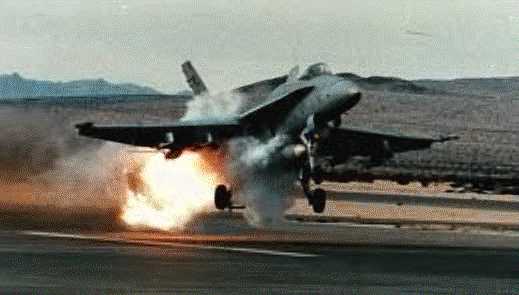
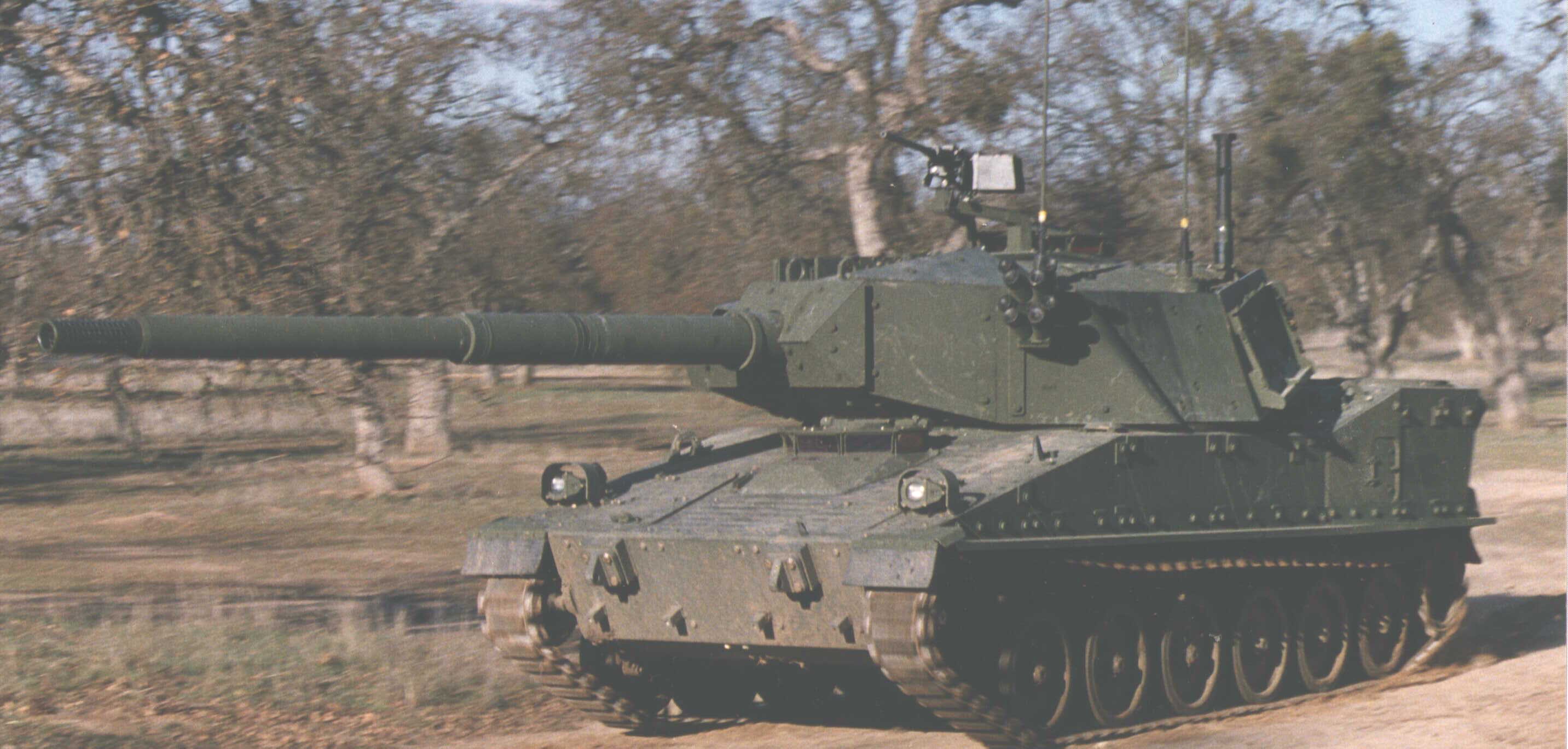
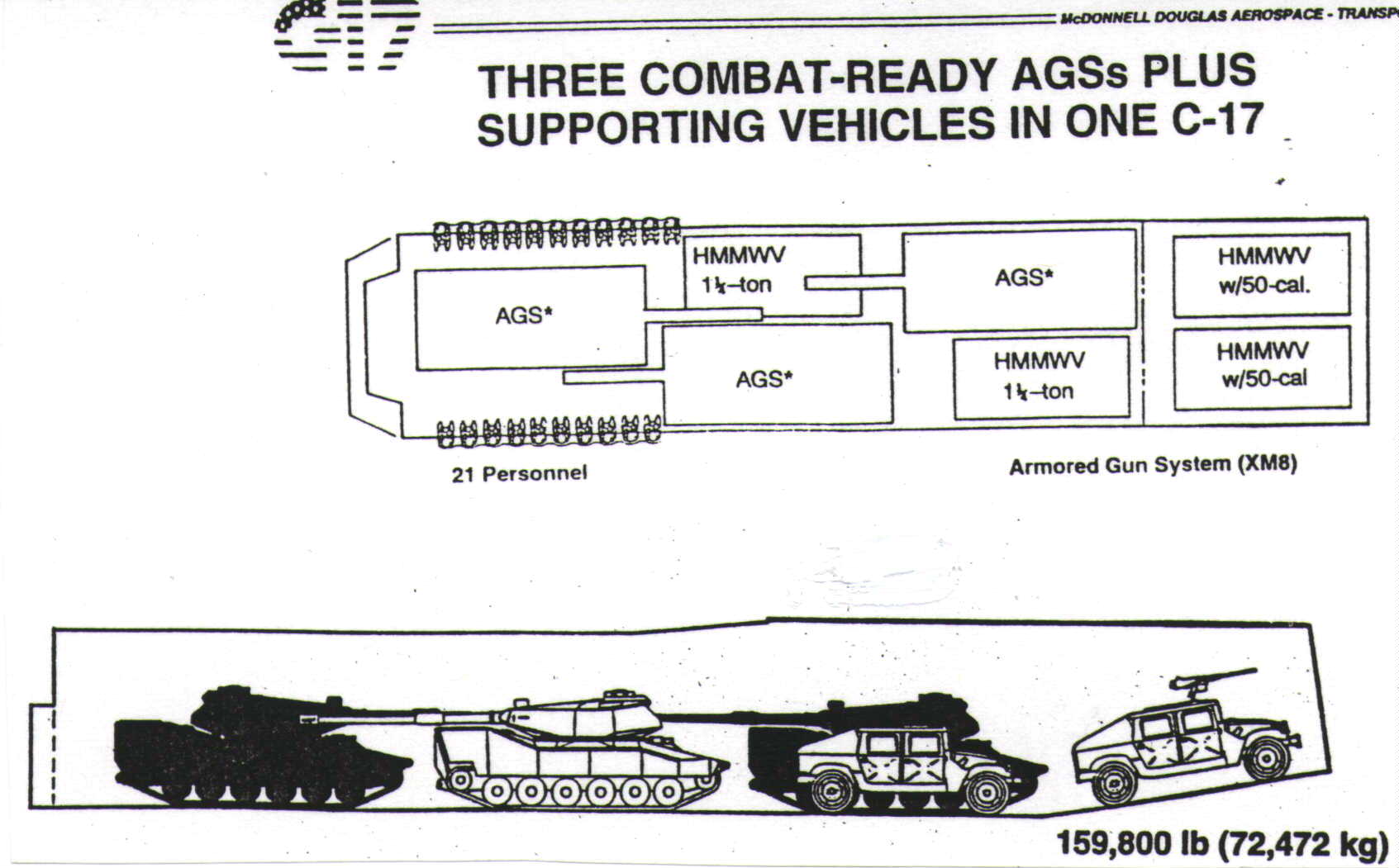
"68% of the 4,963 Canadian troops were casualties and 913 were killed outright.... On August 19, 1942, the Canadians did all that flesh could do against fire, but has been proven on battlefield after battlefield against an aroused, entrenched enemy, courage is not a substitute for fire support..."
 www.youtube.com/v/wVpaoKhj33M
www.youtube.com/v/wVpaoKhj33M
1600 Pennsylvania Avenue
Washington, DC 20500
(202) 456-1414
Fax (202) 456-2461
e-mail
2428 Rayburn House
Office Building
Washington, DC 20515
(212)225-4501
e-mail
FEEDBACK!
Army Times
Published: 09-23-96
Category: COVER STORY
Page: 16
AFTER 30 YEARS, SHERIDAN TANK NEARS CAREER END
By Sean D. Naylor
Published: 09-23-96
Category:
Page: 16
Keywords:
WHAT'S NEXT FOR 82ND AIRBORNE?
Published: 09-23-96
Category: COVER STORY
Page: 14
Keywords:
GOODBYE, SHERIDAN / WHAT'S NEXT AS 82ND LOSES ONLY TANK BATTALION?
Published: 09-23-96
Category: COVER STORY
Page: 15
JULY '97 END OF ROAD FOR TANK BATTALION

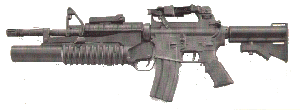 Return to Paratrooper 2000, click on M4 5.56mm Carbine with M203 40mm grenade launcher
Return to Paratrooper 2000, click on M4 5.56mm Carbine with M203 40mm grenade launcher